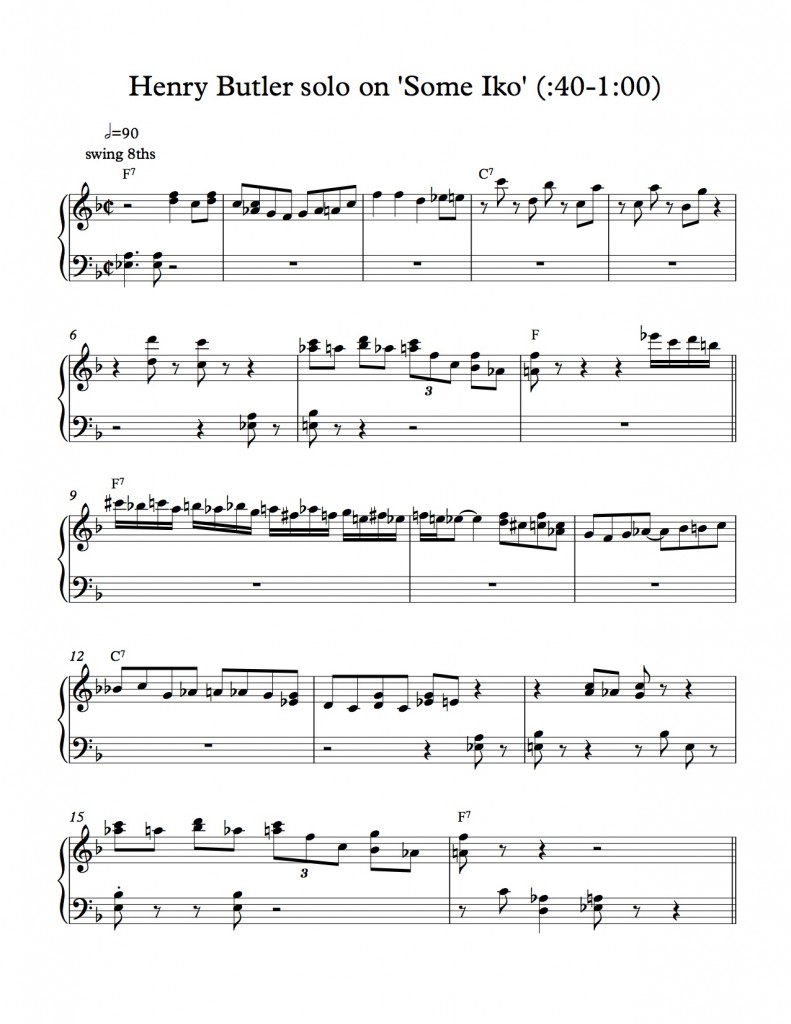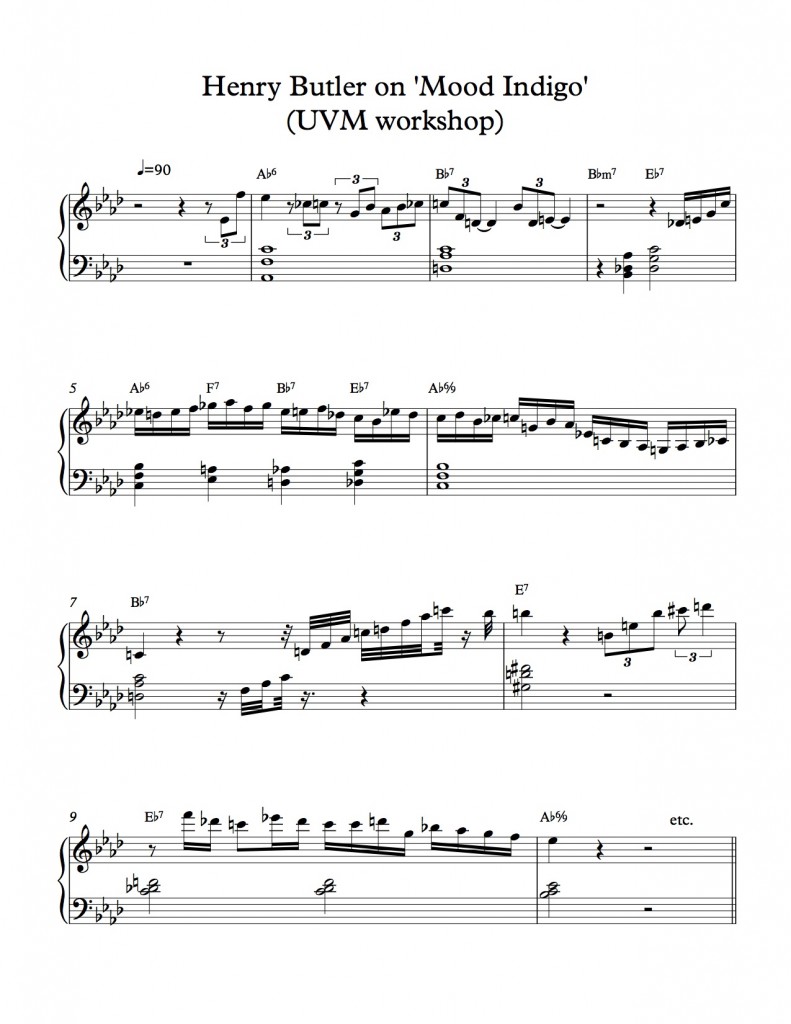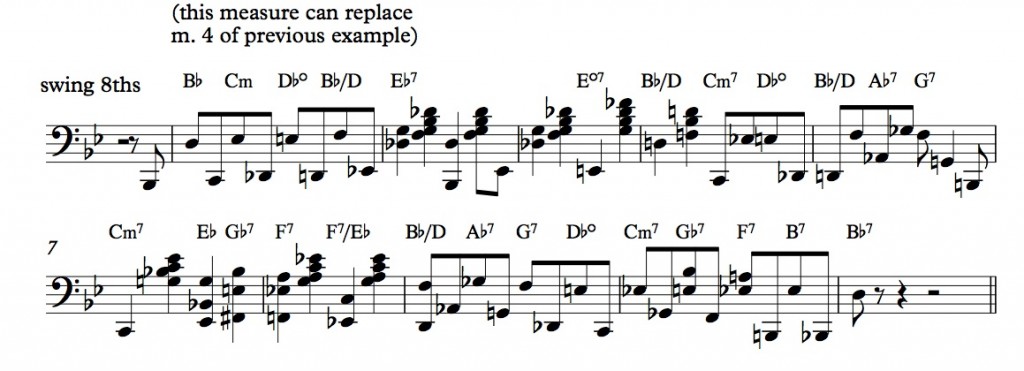Four of my piano students recently played in a workshop with the great Henry Butler, one of the prime exponents of the New Orleans piano style. (Many thanks Steve MacQueen and Madeline Bell from the Flynn as well as Dr. Alex Stewart at UVM for their help in organizing the workshop.) From earlier albums like ‘Fivin’ Around’ to the more recent ‘PiaNOLA’ and the just-released ‘Viper’s Drag’, Butler’s playing has carried forward the innovations of New Orleans pianists like Jelly Roll Morton, Professor Longhair and James Booker and featured Butler’s own unique fusions of harmony (from gospel, blues, jazz, etc.) and modernistic melodic motion.
In advance of Butler’s visit, I transcribed some of Henry Butler’s piano solo on the tune ‘Some Iko’ and studied it with some of my students. It can be heard in a YouTube video featuring Butler with Steven Bernstein and the Hot Nine, the band with which he performed recently at the Flynn. The solo is a great example of how to apply bebop concepts to a simple two-chord progression, as well as of a conversational and melodic approach to comping with the left hand during a right hand melodic solo. I told Butler that I particularly liked the two-handed melodic intro that he plays before getting into the form of the tune, and he mentioned that Frank Zappa keyboardist and jazz/funk keyboard icon George Duke was one of the first people to show him this kind of two-handed technique. This reminded me that I’ve been wanting to transcribe Duke’s solo from the Zappa tune ‘Blessed Relief’. (Maybe I’ll also post a transcription I did of Art Neville’s intro chorus from the Meters tune ‘Cabbage Alley’.) In any case, here’s the beginning of Butler’s solo:
In the first eight bars of this solo excerpt, Butler focuses on using the flatted third of the F7 and C7 changes, which gives the melodic line a more traditional blues flavor. However, both the way that his line closely follows the chord changes, and the way his left hand interacts conversationally with the right (comping in spaces his right hand leaves, rather than playing chords underneath a more continuous line) are more characteristic of jazz players like Wynton Kelly. Starting with the pickup to measure 9, Butler uses the bebop approach of placing non-scale tones or ‘half steps’ on upbeats (for instance, using the half steps between the root and 7th and the 6th and 5th of the F 7th scale in m. 10). His blues-based opening strategy in the first eight bars grabs your attention, but the jazz chromaticism in the latter half of the solo holds it .
In the workshop at UVM a few weeks ago, Butler hit a wonderful balance of criticism and encouragement with my students. While some of the statements I’ve quoted are critical, which is to be expected in a master class, my written quotes don’t fully convey the congeniality with which he delivered these thoughts. I am really grateful for how generously he shared his prodigious knowledge and insight during an hour and a half sandwiched between his arrival in town and a house concert. (Before the workshop, we were also treated to Butler’s harmonically adventurous takes on ‘In Your Own Sweet Way‘ and ‘Love For Sale‘ while he tested out the piano.)
The workshop began with one of my UVM students playing a rendition of ‘Mood Indigo’ that opened with two choruses of stride (a head statement followed by a chorus of solo.) After listening to some of the stride solo, Mr. Butler stopped the student and said: “You’re playing this sort of in a stride style, and I hear in your right hand that you’re intimating that it’s supposed to be a triplet feel or swing feel, right? But in other parts of your playing, I wonder if you’re trying to be in the swing style or in more of an even rhythmic style.” He then demonstrated some ways of adding a swing feel to a stride left hand. (An example of this is in the discussion of ‘Blue Monk’ below.)
In discussing the student’s solo, Butler commented: “You have to compel people to listen, and the only way you’re going to be able to do that is by instituting more contrasting elements. [Your solo sounds] pretty much the same in both choruses. Your first four bars, maybe your first eight bars, could be just the way you started. And then, after that, you need to lift it. One way to lift it is by changing your phrasing to maybe a mix of sixteenth notes with maybe some of what you’re doing [i.e. eighth notes] or triplets.” He followed this with a couple choruses of his own that demonstrated rhythmic variety and swung hard. I’m going to see if I can get Mr. Butler’s permission to post audio excerpts, but in the meantime, here’s a transcription of the beginning:
Later in the workshop another student played ‘Blue Monk’, also leading off with two choruses of stride. Through first talking and then playing a few choruses of his own on the tune, Butler made the point that stride piano is not just the ‘boom-chuck’ combination of a bass line in one range and chords in another, but that it can and should also include elements of swing feel. “If I was going to play it sort of like you were playing,” Butler began, “I would maybe do this.” He then played a stride head statement of ‘Blue Monk’ full of swing and great voice leading in the left hand. He further clarified his approach to stride on this tune by playing a chorus of left hand alone on the twelve-bar jazz blues in B flat, starting with these four bars:
He then paused, perhaps remembering how one of my students had mentioned that he couldn’t reach tenths, a common interval in stride left hand parts. Butler added: “If your hands aren’t big enough to do that, you can do…” and went on to play the following excerpt. He began by taking a different approach to the walking tenths in the last bar of the excerpt above and changing them to what I’d call jump tenths :
Throughout this excerpt, Butler either jumps up a major tenth from the root of a chord to its third(as in the first bar), or up a seventh from the root of a dominant chord to a guide tone (i.e. 7th and 3rd) voicing of it. In these excerpts he also follows the standard jazz piano practice (described in Jazz Keyboard Harmony by Phil deGreg) of keeping the 3rd and 7th of every chord above C3 (i.e., the C below middle C.)
Henry Butler’s visit was an energizing experience both for myself and my students, some of whom have also gotten to play in workshops with other guest artists; over the years I have had the privilege of coordinating workshops with Arturo O’Farrill, Marcus Roberts, Donal Fox, Mike Holaber, Jason Moran and John Stetch. If I can see interest in this post in the form of blog comments, maybe I’ll post some of the transcriptions I’ve done of these great players. Recently I’ve discovered the benefits of transcribing first and asking questions later (as I did with Butler, Roberts, and Fox); but then again, it can also be exciting to chase the traces of a melodic imagination after its owner leaves town. True confession: while I was transcribing Butler’s workshop excerpts, I was dashing back and forth from my computer to the TV to catch updates on the gripping last game of the World Series. It was doubly inspiring to take breaks from decoding Butler’s brilliant piano moves and see the team from the birthplace of the Count Basie Orchestra stride to victory over the team from the birthplace of bebop (who swung hard in their own right.)
I had the pleasure of seeing Henry Butler perform at the Flynn Center during his visit to Burlington, and one of the things I noticed was that he was using both pedals. Did Mr. Butler talk at all with your students about his use of the pedals or can you comment on it?
WOW! I LOVE Henry Butler solos–first time to hear him today. Do you do transcript of Orleans Inspiration?